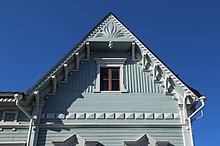
Back جملون Arabic Шчыт (архітэктура) Byelorussian Шчыт (архітэктура) BE-X-OLD Zabat BS Capcer Catalan Štít (architektura) Czech Gavl (bygningsdel) Danish Giebel German Gablo Esperanto Hastial Spanish



A gable is the generally triangular portion of a wall between the edges of intersecting roof pitches. The shape of the gable and how it is detailed depends on the structural system used, which reflects climate, material availability, and aesthetic concerns. The term gable wall or gable end more commonly refers to the entire wall, including the gable and the wall below it. Some types of roof do not have a gable (for example hip roofs do not). One common type of roof with gables, the 'gable roof', is named after its prominent gables.
A parapet made of a series of curves (shaped gable,[1] see also Dutch gable) or horizontal steps (crow-stepped gable) may hide the diagonal lines of the roof.
Gable ends of more recent buildings are often treated in the same way as the Classic pediment form. But unlike Classical structures, which operate through trabeation, the gable ends of many buildings are actually bearing-wall structures.
Gable style is also used in the design of fabric structures, with varying degree sloped roofs, dependent on how much snowfall is expected.
Sharp gable roofs are a characteristic of the Gothic and classical Greek styles of architecture.[2]
The opposite or inverted form of a gable roof is a V-roof or butterfly roof.
- ^ Clarke 2010, p. 106.
- ^ Passmore, Augustine C. "Twenty Styles of Architecture". Handbook of Technical Terms Used in Architecture and Building and Their Allied Trades and Subjects. London: Scott, Greenwood, and Co., 1904. 360. Print.